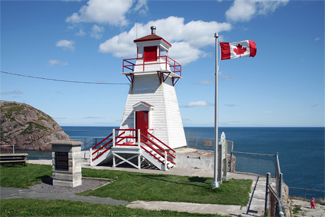Fort Amherst Lighthouse
Heritage Lighthouse
St. John's, Newfoundland and Labrador

Fort Amherst Lighthouse
(© Kraig Anderson - lighthousefriends.com)
Address :
Southside Road, Fort Amherst, Fort Amherst, St. John's, Newfoundland and Labrador
Recognition Statute:
Heritage Lighthouse Protection Act (S.C. 2008, c 16)
Designation Date:
2014-02-07
Dates:
-
1951 to 1951
(Construction)
-
1813 to 1813
(Established)
Event, Person, Organization:
-
Signal Hill National Historic Site of Canada
(NHS or other designated site)
Other Name(s):
-
Fort Amherst Lighthouse
(Designation Name)
Description of Historic Place
The Fort Amherst heritage lighthouse is a square, tapered, wooden tower overlooking the Narrows, the channel leading to St. John’s Harbour in Newfoundland and Labrador. It is located where Fort Amherst, a British military tower and battery, once stood. Built in 1951, it is the third lighthouse on the site.
There is one related building on the site that contributes to the heritage character of the lighthouse: (1) the 1990 office/equipment building.
Heritage Value
The Fort Amherst Lighthouse is a heritage lighthouse because of its historical, architectural, and community values.
a - Historical values
The original Fort Amherst lighthouse was Newfoundland’s first lighthouse, built ca 1813. Constructed by the British inside a fort built to defend their claim to Newfoundland and its rich fishing grounds, the lighthouse served the region’s expanding fishing and commercial interests. During the War of 1812, the lighthouse saw many captured American ships being towed into the harbour. In 1852, a new lighthouse was built due to the original’s deteriorating condition. This second lighthouse would continue to be associated with naval efforts in times of war, as it witnessed military activity during both World Wars. Ships carrying members of the Royal Newfoundland Regiment bound for France and England during the First World War passed the lighthouse as they sailed overseas. During the Second World War, the Canadian Department of National Defense officially took over the lightstation for use as a Naval Signal Station and barracks. The current wooden tower was built in 1951, while the second lighthouse and ruins of the fort were removed a few years later.
Being a naturally sheltered and ice free port, St. John’s Harbour is active year round and is considered one of the East Coast’s most important harbours. For two centuries, consecutive lighthouses at the site have guided vessels of all shapes and functions, significantly contributing to the socio-economic development of the region. Fishers from both St. John’s and those from around the world use the lighthouse in their travels, with the port being a stopover for mariners from countries such as Spain, Portugual and Estonia. While Newfoundland’s cod fishery was affected by the cod moratorium in 1992, other fisheries, including snow crab, scallop and lobster continue to thrive. The offshore petroleum industry and St. John’s increasing popularity with cruise ship companies has also resulted in more vessels passing the lighthouse each year.
b - Architectural values
Fort Amherst is a typical example of a square, tapered, wooden tower design that was used extensively in Canada for more than 100 years. It has a simple profile, with a superimposed gallery supported by metal brackets.
Square, tapered, wooden lighthouses were economical to build, with materials readily available in nearby forests and mills. They have strong durability and are able to withstand heavy winds due to their low centre of gravity.
c – Community values
Perched on a cliff overlooking the North Atlantic, the Fort Amherst heritage lighthouse is one of the first landmarks encountered by vessels upon entering St. John’s Harbour. Surrounded by traditional red and white wooden buildings (an equipment building and two former keeper’s dwellings), the ligthtstation’s picturesque landscape reinforces the city of St. John’s great maritime identity.
Fort Amherst lightstation is a popular and well-loved site for both the local community and for tourists visiting St. John’s. In past decades, the site was a place for community gatherings, having seen tea rooms, a small store and museum in operation. Local residents have dedicated themselves to preserving memories of the lighthouse through books, recordings, and the creation of preservation groups; in recent years, a descendant of a former lightkeeper has renovated the lightkeeper dwellings into vacation homes. Visitors enjoy the views from the lighthouse, which can include sightings of icebergs and whales, as well as views of the lightstation from different vantage points in the city, including from the water and from across the Narrows on Signal Hill. The lighthouse is also prominent in tourist memorabilia in the city.
d - Related buildings One related building, as listed in section 1, contributes to the heritage character of the lighthouse.
Character-Defining Elements
a - The following character-defining elements of the Fort Amherst Lighthouse should be respected: its location overlooking the Narrows channel leading to St. John’s Harbour; its intact, as-built structural form, height, profile and balanced proportions based on the standard design of square, tapered, wooden towers; its square wood-frame structure with tapered sides rising from the brick, stone and concrete foundation base; its tapered shaft covered with white clapboard; its square wooden lantern surmounted by a pyramidal roof covered with red roofing; its superimposed gallery, supported by metal brackets and surrounded by a simple square metal railing; its sole entry door with projecting pedimented surround; its traditional red and white exterior colour scheme consisting of a white tower and gallery, accented by red features such as the door, the lantern detailing, the railing of the gallery, and the roof; and its visual prominence in relation to the water and landscape.
b - The following character-defining elements of the related buildings should be respected: its built form, profile and proportions; its traditional red and white exterior colour scheme; and its contextual relationship to the lighthouse within an evolved historic lightstation setting.